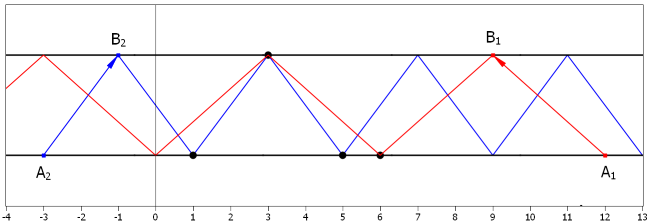| Codeforces Round 509 (Div. 2) |
|---|
| Finished |
You are given a tube which is reflective inside represented as two non-coinciding, but parallel to $$$Ox$$$ lines. Each line has some special integer points — positions of sensors on sides of the tube.
You are going to emit a laser ray in the tube. To do so, you have to choose two integer points $$$A$$$ and $$$B$$$ on the first and the second line respectively (coordinates can be negative): the point $$$A$$$ is responsible for the position of the laser, and the point $$$B$$$ — for the direction of the laser ray. The laser ray is a ray starting at $$$A$$$ and directed at $$$B$$$ which will reflect from the sides of the tube (it doesn't matter if there are any sensors at a reflection point or not). A sensor will only register the ray if the ray hits exactly at the position of the sensor.
 Examples of laser rays. Note that image contains two examples. The $$$3$$$ sensors (denoted by black bold points on the tube sides) will register the blue ray but only $$$2$$$ will register the red.
Examples of laser rays. Note that image contains two examples. The $$$3$$$ sensors (denoted by black bold points on the tube sides) will register the blue ray but only $$$2$$$ will register the red. Calculate the maximum number of sensors which can register your ray if you choose points $$$A$$$ and $$$B$$$ on the first and the second lines respectively.
The first line contains two integers $$$n$$$ and $$$y_1$$$ ($$$1 \le n \le 10^5$$$, $$$0 \le y_1 \le 10^9$$$) — number of sensors on the first line and its $$$y$$$ coordinate.
The second line contains $$$n$$$ integers $$$a_1, a_2, \ldots, a_n$$$ ($$$0 \le a_i \le 10^9$$$) — $$$x$$$ coordinates of the sensors on the first line in the ascending order.
The third line contains two integers $$$m$$$ and $$$y_2$$$ ($$$1 \le m \le 10^5$$$, $$$y_1 < y_2 \le 10^9$$$) — number of sensors on the second line and its $$$y$$$ coordinate.
The fourth line contains $$$m$$$ integers $$$b_1, b_2, \ldots, b_m$$$ ($$$0 \le b_i \le 10^9$$$) — $$$x$$$ coordinates of the sensors on the second line in the ascending order.
Print the only integer — the maximum number of sensors which can register the ray.
3 1
1 5 6
1 3
3
3
One of the solutions illustrated on the image by pair $$$A_2$$$ and $$$B_2$$$.
| Name |
|---|




